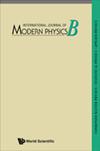P-type Gallium nitride creation through O+ implantation
IF 2.6
4区 物理与天体物理
Q2 PHYSICS, APPLIED
引用次数: 0
Abstract
P-type GaN was successfully achieved by vertically implanting positive monovalent cations of oxygen (O[Formula: see text]) into undoped (native n-type with an electron concentration of [Formula: see text][Formula: see text]cm[Formula: see text]) (0001) monocrystalline GaN. This implantation was carried out with an energy of 200[Formula: see text]keV and a dose of [Formula: see text] ions/cm2. In the absence of subsequent rapid thermal annealing (RTA) or when exposed to RTA at 950°C for 10[Formula: see text]s in a nitrogen ambient environment, temperature-dependent Hall measurements in a vacuum consistently indicated stable p-type conductivity. For the sample that underwent subsequent RTA, the room-temperature Hall hole concentration measured [Formula: see text][Formula: see text]cm[Formula: see text], the Hall resistivity was 0.44[Formula: see text][Formula: see text][Formula: see text]⋅[Formula: see text]cm, the Hall hole mobility reached 17.81[Formula: see text]cm2[Formula: see text]⋅[Formula: see text]V[Formula: see text][Formula: see text]⋅[Formula: see text]s[Formula: see text], and the acceptor ionization energy was determined to be 0.08[Formula: see text]eV. The doping efficiency was calculated at 5.5%. O[Formula: see text] ions effectively serve as acceptors, whether annealed or not. The p-type conductivity induced by O[Formula: see text] implantation in GaN is notably advantageous and holds practical significance for the ongoing development of future device technology.通过 O+ 植入创造 P 型氮化镓
通过向未掺杂(电子浓度为[式:见正文][式:见正文]cm[式:见正文]的原生 n 型)(0001)单晶氮化镓中垂直植入氧(O[式:见正文])的正一价阳离子,成功实现了 P 型氮化镓。植入的能量为 200[式:见正文]keV,离子剂量为 [式:见正文]/cm2。在没有进行后续快速热退火(RTA)或在氮气环境中于 950°C 下暴露于 RTA 10[式中:见正文]秒的情况下,在真空中进行的随温度变化的霍尔测量始终显示出稳定的 p 型导电性。对于随后进行 RTA 的样品,室温霍尔空穴浓度测量值为[式:见正文][式:见正文]cm[式:见正文],霍尔电阻率为 0.44[式:见正文][式:见正文]⋅[式:见正文]cm,霍尔空穴迁移率达到 17.81[式:见正文]cm[式:见正文]。81[式:见正文]cm2[式:见正文]-[式:见正文]V[式:见正文][式:见正文]-[式:见正文]s[式:见正文],受体电离能确定为 0.08[式:见正文]eV。计算得出的掺杂效率为 5.5%。无论退火与否,O[式:见正文]离子都能有效地充当受体。在氮化镓中植入 O[式:见正文]离子所诱导的 p 型导电性具有显著的优势,对未来器件技术的持续发展具有重要的现实意义。
本文章由计算机程序翻译,如有差异,请以英文原文为准。
求助全文
约1分钟内获得全文
求助全文
来源期刊

International Journal of Modern Physics B
物理-物理:凝聚态物理
CiteScore
3.70
自引率
11.80%
发文量
417
审稿时长
3.1 months
期刊介绍:
Launched in 1987, the International Journal of Modern Physics B covers the most important aspects and the latest developments in Condensed Matter Physics, Statistical Physics, as well as Atomic, Molecular and Optical Physics. A strong emphasis is placed on topics of current interest, such as cold atoms and molecules, new topological materials and phases, and novel low dimensional materials. One unique feature of this journal is its review section which contains articles with permanent research value besides the state-of-the-art research work in the relevant subject areas.
 求助内容:
求助内容: 应助结果提醒方式:
应助结果提醒方式:


